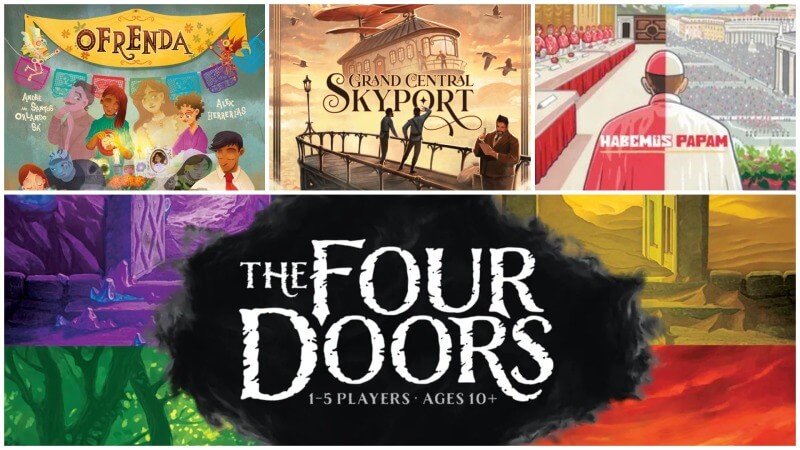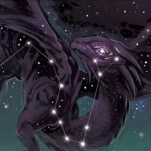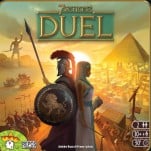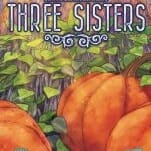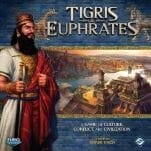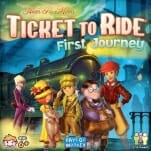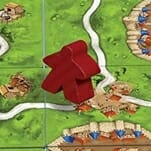Part of one of this year’s trends of taking complex games and crafting simpler versions more suitable to family play, Great Western Trail: El Paso comes in around half the playing time of the original Great Western Trail—my favorite complex game of all time—but strips out a lot of what makes the original so good. There’s no track of delivery stops with stations to visit and bonuses for the first player to reach them. The laborers are all simplified and the conductors in particular now just get you some one-time bonuses. The track on the smaller board doesn’t have hazards or bandits, and stopping at someone else’s building doesn’t cost you. So now it’s a pickup-and-delivery game that still has the same deck management aspect of the original, but almost anything punitive is gone, and it’s much, much easier to teach and to manage all the cognitive load. The result is that it’s a solid light- to medium-weight game that suffers entirely because it is a Great Western Trail spinoff. I don’t think this is a bad game in any way, but I can’t look at it without thinking “but Great Western Trail does this better.”
Bézier: The big deal at the Bézier booth was the prototype of The Game Makers, currently on Kickstarter, where players compete to design, manufacture, and sell actual board games, with over 300 real titles represented within the game. They also had Scream!, another small-box trick-taker that takes their game Scram! and adds a bluffing element.
Bitewing: Bitewing had five titles from Reiner Knizia, three of which were remakes and three new titles. The new titles included Iliad, an abstract game at heart (aren’t all of Knizia’s designs, though?) where you play as the Trojans or the Greeks, trying to place your tiles of varying strengths in a way that you can complete a row or column on the 6×6 board to collect one point tiles from the perimeter, some of which are quite negative, and where your opponent must then take the tile at the other end; and Orbit, a path-finding game where players try to move as quickly and efficiently around the board to visit all of the planets in the solar system and return to their home planets before anyone else does. The remakes included SILOS, a new version of his game Municipium, an area majority game where here aliens are abducting humans (like they do). The UFO moves around the board and scores each area it visits, so you can try to bulk up in one spot on the board right before it scores. If nothing else, it is a massive improvement on the theme and art of the original, which looks like it came from a 1980s sixth-grade social studies textbook. Ichor, a remake of a game published as Tiku in 1993 and later as Battle for Olympus, is a two-player game where you move your characters across the board, placing chips from your supply in their wake, with the goal to place all of your chips before your opponent does. You can remove your opponent’s chip by crossing it, but you can’t jump over another character. It’s slightly asymmetric, as each player also gets one single-use power. The last remake was EGO, a remake of his game Beowulf: The Legend, where players move through various events and participate in auctions—although this mechanic is easier than it was in the Beowulf version.
Broadway Toys: This Hong Kong-based publisher brought out a new edition of the long out-of-print game Panic on Wall Street, which got one print run from Asmodee about 12 years ago, calling it Wolf Street while keeping much of the original’s mechanics. It’s a game for three to 11 players where they split up into teams, half buyers and half sellers, making real-time bids to try to invoke the feeling of the trading floors on Wall Street. Each game has two winners, one from each side. They also had Wondrous Museum, an engine-building game where you’re buying artifacts for your magical museum, and taking a new artifact lets you activate all of the ones you’ve already taken that have the same icon—in the order you’ve placed them. It’s a modular game where you choose two of the six modules for each play, making the rules and scoring different each time.
Capstone: Capstone offered media members a preview of their upcoming game Sanctuary, a midweight adaptation of the hugely successful game Ark Nova, which is so big I can’t play it on my dining room table. Sanctuary strips a lot of Ark Nova’s complexity away, including the twin scoring tracks, the cards, and the polyomino tile placement, but keeps the action-selection mechanic where an action becomes more powerful the longer you go without choosing it. The scoring is still extremely involved, and I’m sure dedicated Ark Nova players, of which I am not one, will have Big Feelings about it like I did about Great Western Trail: El Paso. It’ll be out at Essen in October. They also had Suna Valo, a two-player farming-themed engine-builder from the designer of La Granja; the massive economic tile-placement game Raising Chicago; Tea Garden, another heavy game of deckbuilding and resource management that has a brightly colored board that faked me into thinking it was a lighter game from the designer of Galileo Galilei (which Capstone had for sale, but sold out of quickly); and Butterfly Garden, a rethemed, updated version of Reiner Knizia’s 2012 tile-laying game Indigo.
Chilifox: The Svensson brothers, founders of Chilifox, have a new game they designed together, modestly called Spectacular. It’s a tile-drafting game where players have tight boards, as in Calico, but with more ways to hack the rules a little and create some more flexibility. Players are building wildlife parks with the tiles and selecting dice to provide food for the animals, with the tile and die draft providing interaction, and then the placement phase simultaneous to keep play times to 30 minutes or less.
Darrington: This publishing imprint of the Critical Role troupe had Solar Gardens, a very light tile-drafting and laying game where you try to connect paths, set up animal habitats, enclose gardens with water features, etc. It seemed extremely simple when someone in the booth explained the rules.
Dead Alive: Lunar Skyline is a trick-taking game where you bid on how many tricks you’ll win, with certain symbols on the cards that make those worth more points if you win them. It takes its theme from their economic worker placement game Lunar Rush, but it’s a standalone game with none of the latter’s mechanics. Cat Rescue is a new edition of the 2018 game of that name, published by the designer Ta-Te Wu under the Sunrise Tornado imprint. Players place cat cards into the grid to try to complete a row or column, at which point the middle cards are flipped over, showing that they’re ready to be adopted. Flipped over cards that are then pushed off the grid are considered rescued, while face-up cards that are pushed off are sent back to the mean streets. The original was cooperative, but this version adds a competitive mode. Kittens in Space is a card-shedding game that combines the themes of the other two: players are rescuing stray kittens … on the moon. Players play their cards to the central ‘ladder’ of cards, where what you play can shift the direction of play, so you may have to play higher or lower cards, and are restricted in what stacks in the ladder are available.
Detestable Games: They had a game called War for Chicken Island, which is up for the Game Name of the Year, at least. You’re rolling dice to move your chicken miniatures around a hex map to try to control more areas and accumulate chicken leaders, although there’s no player elimination in the game.
Devir: As usual, Devir cranked out a few entirely new heavy Euros; I think they only showed one item that was a spinoff or sequel to something else, and I’ll give them a pass on that one—it’s The White Castle Duel, due out later this year, which completely reimagines my 2023 game of the year to the point that it doesn’t share a ton beyond the theme. It has no dice, which is the most shocking part, with a track each player will move down over six turns, and then will replay in reverse order over six more turns. Transgalactica is a big-board worker placement game from Daniele Tascini (Tzolk’in) with a ton of player interaction; the listed playing time was 100 minutes, which I note just because 120 or 90-120 is so standard for heavy Eurogames. Phoenix New Horizon launched its US release at the show; it’s another big Euro, this one in a post-apocalyptic setting, with a large board and a million pieces and tokens. Red Carpet is an “action programming” game where players try to move various standing figures representing various actors and celebrities from Hollywood’s Golden Age so that they can each take a picture with their (actual) phones to satisfy their own objective cards. It reminds me a good bit of Picture Perfect, which came out a few years ago, although the theme and the specifics of scoring differ. And Quorum is a midweight card management game where players compete to move around the tracks for six different provinces, each of which scores a little differently, and where players can manipulate the scoring multiplies for each to try to maximize their own gains or keep other players from scoring there at all.
Dice Throne: Dice Throne had several new products in their licensed Marvel line, along with new heroes in Dice Throne Outcasts and an expansion to their Adventures game called Unchained. Slam Throne is a collectible dexterity game that’s loosely in the Dice Throne universe, where players use their ‘slammer’ to try to flip the other player’s caps for damage. They had a Gen Con exclusive version but it’s not out to retail yet.
Dire Wolf: Lightning Train is a pickup-and-delivery and bag-building game set on a North American map where players build out train lines to try to grab various goods and fulfill contracts by delivering them to specific cities or regions on the map, opening stations to expand their reach. It’s from Paul Dennen, designer of Clank! and Dune Imperium.
DVC: DVC had a prototype of Inkwell, a color-matching game where players play as monks trying to decipher old texts and score for completing part or all of each of their cards, where one catch is that you can only take a batch of colored cubes if you have legal plays for all of them. It’s due out in February.
Envy Born: Hercules and the 12 Labors is a solo game where players—excuse me, the player—rolls dice to fight a dozen opponents from the Greek myth, using dice to do damage or unlock abilities, with each defeated foe granting the player some new power or benefit for future battles. It’s available for pre-ordering now.
Flatout: Knitting Circle is a sequel game to Calico, but much more forgiving—you might even call it cozy—as it doesn’t have the earlier game’s constraint of a frame into which you place your tiles. Point Galaxy is the third game in the Point series, after Point Salad and Point City, once again having players draft cards and add them to their play area, this time trying to create numerical sequences and meet objectives on cute rocket tokens. And Cascadia Junior is a kids’ version of the fantastic tile-laying game that has also produced multiple spinoffs, including two roll-and-write games.
Floodgate: Hedge Mage is a tile placement game with a fun twist: You place tiles on your own board, but your mages are on your neighbor’s board trying to pick up gnomes and other rewards, so every player is trying to place tiles to thwart the next player’s mages while moving their own. I didn’t get back for a demo of Squirrel Away, a new set collection game from Clarence Simpson (The Wolves), which was busy every time I went by.
Gamehead: All of Gamehead’s titles come in the same small square box format, which is great for keeping things organized. They had the most intriguing party game—not my preferred game style—I saw at the Con in First Class Letters, which has a Boggle vibe and scales to any number of players. You roll dice once to determine the three starting letters everyone needs to try to fill out their sheets, then roll the rest to give the complete set of letters to use in that round. Players then try to find the longest anagrams they can, filling out their sheets in alphabetical order, with some of the lines blank and some showing the starting letters. Trinket Trove is a set collection game where your cards are in your hand the whole game, and you use some of those hand cards—the same ones you’re trying to amass for points—to bid for turn order to claim cards in each round, where the cards you placed aren’t discarded but are up for anyone else to claim. All card types increase more than linearly as you collect more, but how many you need to get to the big bonuses varies by type. Venture Angels is (I believe) the first U.S. release of a 2018 game designed by Bruno Faidutti with fabulous cartoon art from Ian O’Toole, where players bid on various startup projects. If a project doesn’t get enough funding in total bids compared to its face value, no one gets it; then the remaining project that is the most overfunded is discarded as well.
Ghost Galaxy: The brand-new edition of Reiner Knizia’s two-player game Lord of the Rings: The Confrontation, co-designed by Eric M. Lang and Christian Peterson, is the first new English version to come out in 10 years. It’s another upgrade from the 2005 version, which took the original’s small box format and gave it a big board with 3D figures so it would have more table presence. This edition comes out next year. The real showstopper at the booth was their $3000 custom table, however, with a gold inlay around the outer edge that depicts the entire story of The Lord of the Rings trilogy via images.
Good Games: In addition to 12 Rivers, Good Games had Cytress, a heavier engine-building game that also has a 3D aspect to the board, a structure with multiple levels to which you’re trying to send your workers. There’s worker placement, area control, and tableau-building aspects to the game as well, with a dystopian theme set on a skyport where the wealthiest humans have escaped Earth’s devastation. (Stop the world, I want to get off, too.) They also had an expansion for their 2021 hit tile-laying game Land vs. Sea called Uncharted, adding more tiles and three new ways to score, making the game a little meatier than the original light, family-level game is.
Hachette: Tag Team is a two-player ‘auto-battler’ where each player gets two characters with unique powers, hit point levels, combat abilities, and card decks. You start your combat deck with the base card for each character and arrange them in either order, which will not change for the rest of the game. You then shuffle both of your character decks together and draw one new card per round, adding it to the top or bottom of your combat deck, so you determine the order of operations, which can include hitting your opponent, healing, or using/boosting your own special abilities. Gwent is a two-player game that came out of The Witcher video game series, as players compete to win the best two of three by playing with 10-card decks you construct from various faction decks before each game begins. Leaders is a quick two-player game where you’re trying to capture the opponent’s leader on a hexagonal board, adding allies, each with a unique power, on your first few turns until each player has four allies on the board. Then it’s all movement and strategy as you try to either get two of your allies next to the opponent’s leader or surround your opponent’s leader so that it has no legal move. Also, the board has a full drawer in it.
Happy Camper: The Four Doors is a new small-box cooperative game from Matt Leacock (Pandemic), with an assist from Matt Riddle and Ben Pinchback (Three Sisters); it’s Forbidden Island without the modular map, as here players are playing cards from the single deck to the left or right of one of the four doors (cards) in a column on the table. The goal is to get all four relics from behind the doors and then get all players to the exit space before the shadows destroy one of the doors, the card deck runs out, or the shadow level hits its max. Jungo is a card-shedding game like UNO or SCOUT, and like SCOUT this one requires you to keep your hand as it’s dealt. You play a single card or a set to the center, trying to beat what’s already there (but you can’t play a set to beat a single), and if you do so you have the option to pick up the cards in the center—placing them wherever you’d like in your hand—or discard them.
Horrible Guild: Railroad Tiles is a standalone game that takes the theme and some of the mechanics of the roll-and-write Railroad Ink series, this time with players laying tiles on to their own map to try to connect roads and rails and score for different types of meeples. They had the third expansion for Evergreen, Cherry Blossoms, but it sold out almost immediately.
Hot Banana: Moon Bunny has players moving their two leporine alchemists around the 6×6 tile board, with only one of them active at a time and each moving in a distinct way, to build a tile tableau and gather the ingredients to fulfill spell recipes.
Inside Up: Ice & Idols is a pickup-and-delivery game with some pattern scoring, played on a gorgeous, rotating, multi-layered board, where your moves can turn the board or move walls on it to try to slow down your opponents. Perch is an area control game about birds—I will never stop assuming this game is about a fish—where players draw birds from a bag and use them to compete for control of eight different locations. Those locations vary by game, with 30 in the box, and there are also objective cards that can also change by session. And they had the newest expansion for Earth, Abundance, which adds the components for a sixth player and adds an entirely new action, Germinate, which lets you hunt through the deck for the card(s) you need.
Keymaster: The second edition of Parks has way better art—it’s brighter and easier to read and look at—with some rule changes that address a few of the things I didn’t love about the original. The gear is more powerful now and the canteen function draws some of the benefits in the Parks Stroll & Hike game, with the canteen also getting its own two-ply boards. They also had a prototype of Hanami, the long-overdue reprint of my favorite Reiner Knizia game ever, Samurai. Hanami rethemes it where players compete to get the best spots under the cherry blossom trees to have their picnics, and it will come with the classic Japan board and a new, variant Tokyo board. Samurai should never go out of print, so I was ecstatic to see this.
KOSMOS: Australis is a righteous dice-drafting game set in the Eastern Australian Current, where players select dice to feed fish, place tokens on coral reefs, move down the current track, or try to improve their spot in the turn order. There’s also an end-of-round contest where players roll dice to try to compete for additional bonus cards that gives it a casino feel. KOSMOS has brought back Caesar & Cleopatra, a two-player game from 1997 by one-hit wonder designer Wolfgang Lüdtke, giving the card-based game its first new English edition in 25 years. The Exit: the Game series has now moved into the Catan world, with Exit: Adventures on Catan—it’s a nice place to visit, but I wouldn’t want to live there—as well as added a new bigger-box Advent Calendar game and more Kids and Family games with simpler puzzles. Masters of Crime, the murder-mystery game series, has a new module out in Mosquito, which spoofs the Indiana Jones series. There’s also a lighter version of their Spiel-winning cooperative trick-taker The Crew, just called The Crew: Family Adventure.
KTBG: Lairs, due out in 2026, is a Battleship-like game where you prepare a dungeon for your opponent to try to navigate, putting up walls and obstacles. On a turn, you tell your opponent in what direction you wish to move, and they’ll have to tell you what you ‘see,’ such as whether there’s a wall in front of you. No word on whether the game has a Grue. How to Save a World is a competitive game where players are working as scientists to try to save a doomed planet that has a giant asteroid speeding towards it—great, so what’s the bad part?—by completing one of two technologies, or by being in the best overall position if the game ends before then and the planet has to be evacuated.
Luma: Luma has risen from the ashes of Flat River Group and is working with several of the publishers who used to distribute through the latter company. In addition to Zenith, they had the new edition of Yokohama Duel by Synapse Games; it’s a two-player spinoff of the economic game Yokohama, both of which are worker-placement games. This new edition has a brighter, cleaner board, and streamlines the rules but seems otherwise faithful to the original. Luma also has a new TCG called CookieRun Braverse that’s been out for some time in Korea and is already up to its seventh set. The first two sets were released in the U.S. in July. They also have picked up Playpunk’s game Zenith, a two-player capture-the-flag game that is my favorite new game so far in 2025. I reviewed it in May.
Matagot: The Peak Team is a cooperative card-drafting game from Scott Almes (the Tiny Epic games), where players are park rangers moving around the board to monitor wildlife and check various locations to fulfill their own objective cards, with all players winning if everyone completes all of their objectives before they exhaust their actions. It was on sale at Gen Con in an early release, with the full release coming in October at Essen.
Mindware: Ringer has one die and a deck of cards in various suits numbered one through six… but the cards all have a hole in the center, and while they don’t need to have that, it’s a smart design move. One player rolls the die in each round and then players alternate playing cards around it, moving up or down from the die or the last card played, to try to match the die’s value and win the stack. Each card is worth a point once the deck is exhausted, ending the game.
North Star: Nature is the reimagining of North Star’s flagship game Evolution, streamlining the rules so it’s easier to learn and to get going on the table. Players still grow species, adding up to three traits to each to customize those species to allow them to accumulate more points. The game’s system is modular, allowing players to play with any combination of the seven current full and mini-modules, so each game can be different.
Oink Games: The Japanese publisher Oink keeps increasing their presence at U.S. conventions, thanks to a few of their signature tiny-box games like SCOUT and Deep Sea Adventure. They had two new ones of note this year, a push-your-luck set collection game called TRND and an abstract deduction game called Dying Message. In the latter, one player is the victim and has to use cards with symbols (but no text) on them to try to communicate to the other players who killed them.
Osprey: Ofrenda takes the Mexican tradition of creating an altar on Día de los Muertos to honor one’s dead relatives and turns it into a card-drafting and pattern-building game. Players try to draft 12 cards to fill out the three rows on their ofrenda boards, and to add candles between the rows, and to light them so they’re worth points at game-end. One spot in each row is a ‘golden’ slot that’s worth double the points of all of the others.
Pandasaurus: Pandasaurus had Gatsby, which I’d previously played, a two-player game that is extremely interactive—to the point of becoming spiteful—where players compete on three mini-boards, each of which works differently, to try to gain influence and capture the 12 characters on the board. You win by getting three characters of the same background color or one of each, or based on the stars on your characters when the game ends. The theme is very pasted-on, though. Shackelton Base is from designer Fabio Lopiano (3 Ring Circus), and it’s a beast—I played this one in full, which took three hours for four players (maybe because we started around 11 p.m. … and there was bourbon). It’s a heavy worker-placement game about building out a base on the moon and exploiting the various corporations trying to cash in on the moon’s resources, where the corporations can change each game, making the goals and strategies very specific to each play. I actually like the game quite a bit for what it is, although that length of game is beyond me. Paper World is a cute set collection game where you’re trying to build stacks of cards numbered one through five in various colors, but your stacks must increase in value as you add cards, and you score for making certain patterns or for getting higher-valued cards on top. Tricky Kids is a trick-taking game where the cards are blank; you get a hand of seven cards and must write numbers on them, with the sum equal to 21. The cards do have three suits, and the value of each suit will vary trick to trick, with tiles placed at the start of the round so you can plan accordingly. They also had a few spinoffs and reissues: Hacienda is a modest classic from Wolfgang Kramer, updated by designer Daryl Andrews; Beasts is a co-operative game based on the card game called The Game; The Mind Soulmates is a standalone game where one person gets to be The Seer, looking through the deck and giving other players a single clue; and both of the tiny-box games Sea Salt and Paper and Pixies, published by Bombyx in Europe, got expansions, with the former selling out in a day.
Paverson: Luthier is a mammoth game about making classical instruments for the great European composers, with worker placement and secret auction mechanics. I know people who are mad for this game, but I have not been able to get my head around it after seeing it twice at cons now. Paverson also has a new expansion coming to Kickstarter soon for their excellent heavy game Distilled called Cocktails, with a separate board showing a small world map for players to compete for area control.
Pegasus Spiele: Living Forest Duel is a two-player version of the Spiel-winning game Living Forest, which I think is fantastic with three players and does not work well at all with two. The Duel version has the players working from a shared deck that they build together, trying to rig it to favor their own side, with four different ways to win—you can gather eight fire tokens from gathering enough water, finish your 3×3 tree grid by gathering enough planting powers, move the fire track token to your opponent’s end twice (looping around once), or replacing all three of your opponent’s cards in the market with three of your own. It’s more complicated to learn than the original, but I think it retains its spirit well while providing a much better push-and-pull experience. Rival Cities is a midweight two-player game from Andreas Steding, who designed Hansa Teutonica, and this game sure looks like that one. Players are building ships, creating alliances, delivering goods, and more, using a rondel action mechanism to select their moves. The game also has multiple win conditions. Roaring 20s has nothing to do with that decade except that the dinosaurs on the cards are wearing flapper outfits and the like. It’s an auction and set collection game where cards have stars on them for points, but you get more points if you create sets or runs. They also had a separate booth to show off Bomb Busters, the cooperative deduction game that won this year’s Spiel des Jahres.
Red Raven: This year marks the 10th anniversary of their hit narrative game Above & Below, so they’ve issued a new edition/sequel called Above & Below: Haunted, which includes a lot of new material including all of the original core game plus a new storybook and many of the old expansions. It debuted at Gen Con. They have also announced Six Sojourns, a remake of the great game 8 Minute Empire, and the development of an app for their underrated game Roam, coming from the developer Hungry Samurai later this year. (All of the above games are by Ryan Laukat, owner of Red Raven.)
Renegade: Renegade’s booth was mostly filled by Heroscape, their popular series of miniature wargame products, but they did have a couple of tabletop releases. Naishi came out last year in Europe, from two first-time designers (both of whom are French, not Japanese); it’s a two-player game set up like a capture-the-flag title, but you’re only drawing cards from the five in the center, discarding cards from your own line of five or your hidden hand to try to create the best-scoring tableau of ten at game end. Each card type scores differently, some by placement, some by set collection, some by synergy with other cards. They sold out of their other two before I got to their booth—Skara Brae, a new solo or competitive title from Shem Phillips (Raiders of the North Sea), with worker placement and resource aspects, but no connection to The Bard’s Tale; and The Anarchy, a city-building game set in the 12th century English period of that name.
Roxley: Santorini Pantheon is the deluxe, Kickstarter version of the abstract two-player game, including all of the various expansions with gods and other powers; while there’s also a new cooperative adventure campaign game for two players called Santorini: The Riddle of the Sphinx. What I really want is for the game to come with a bottle of olive oil from that Greek island, and then I’ll pay double for it. They also teased a small box, Love Letter-like deduction game called Excalibur that will be out later this year or early next.
Salt & Pepper Games: This Spanish publisher made what I think was their Gen Con debut—I’ll be looking for their Donruss Rated Rookie card—with the very timely Habemus Papam, a game where players try to influence the selection of a new Pope. The candidates have four traits, each of them binary, like conservative or progressive, and players have secret objective cards showing the traits they want in the eventual winner. Players negotiate and bluff, trying to figure out what traits their opponents favor. They also had a prototype out of The Voynich Puzzle, a heavy game from Dani Garcia (Barcelona, Daitoshi) that’s based on the infamous Voynich manuscript. Players all work to “decipher” the manuscript, but it’s a competitive game with a 35-page rulebook, including tile placement and deckbuilding elements. It’s launching a campaign on Gamefound next week.
Slugfest: Positano was here last year as a prototype, and now it’s out, with players constructing buildings across a three-dimensional board that represents the cliffs of the titular Italian village. Your perfect view of the sea may be blocked, however, by another player’s move to put up a building right in front of yours.
Tabletop Tycoon: Trailblazer: The Arizona Trail is a worker-placement game with a lot going on on its board, including a mural of polyomino tiles, four biome tracks to move up to gain big rewards, and dueling scoring tracks that move in opposite directions as in Ark Nova and Rajas of the Ganges. It’s the sequel to the 2023 game Trailblazer: The John Muir Trail. They also had the latest game in the Everdell series, Silverfrost, a longer and more complicated game that shares a lot of the original’s worker-placement mechanics; and their recently-acquired titles by designer Eric M. Lang: Blood Rage, Rising Sun and Ankh.
Thunderworks: FlipToons is a short deckbuilding game where you’re trying to keep your deck as lean as possible, taking two actions per round to buy or dismiss a card. The goal is to create a 2×3 grid of cards where they score at least 30 points, which triggers the end of the round. Cards have all kinds of interconnected scoring rules, and some allow you to break the 2×3 grid by stacking cards on each other for more points.
Trick or Treat: Trick or Treat had new editions of two out-of-print games. Camp Grizzly is a slasher film-themed game that was self-published by the designer and artist in 2015, with used copies selling for up to $600 in the last few years. Trick or Treat is giving the semi-cooperative game its first proper publishing run, with updated art, some rules tweaks, and a new two-sided board that adds a second camp map. It’s going to Kickstarter very soon. Treasure of the Dwarves is a rethemed version of a Bruno Faidutti game previously published under the lovely title Dreadful Circus, and I can’t imagine why that wasn’t a hit. In this version, which plays three to eight players, you put treasures up for sale during your turn and take “sealed” bids from all other players. You evaluate them in sequence, and at each one, you must decide to accept it—discarding all other bids—or discard that one, after which you can’t go back to it. Some treasures have special abilities while others are straight victory points.
Keith Law is the author of The Inside Game and Smart Baseball and a senior baseball writer for The Athletic. You can find his personal blog the dish, covering games, literature, and more, at meadowparty.com/blog.
